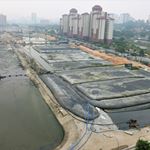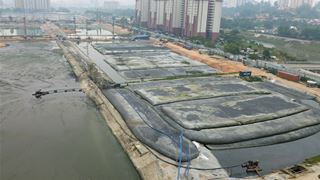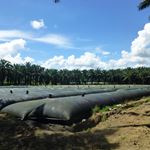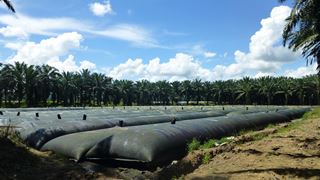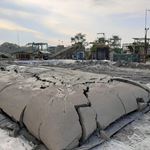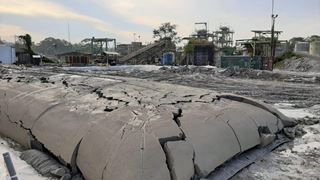Case story
High Profile Brisbane River Geotube® Dewatering of Submerged Stormwater Pipe Sediments
Australia, Brisbane
In a first of its kind application in Australia a specially designed remote-controlled underwater dredger was deployed to excavate and clean out a blocked stormwater drain discharging into the Brisbane river. Exhumed sediments were pumped into Geotube® dewatering units placed on a barge moored in the river. This technically difficult project required a variety of innovative solutions to meet operational and environmental requirements.
The challenge
The submerged location of the outfall of the pipe required the dewatering be conducted from barges moored in the Brisbane river. The challenge faced by the specialist contractor was how to contain sludge excavated from a blocked stormwater pipe by a remote-controlled underwater dredger operating in constricted conditions in a location highly visible to the public and required to meet stringent environmental and operating mandates.
Challenges ranging from identifying a method of containing and dewatering dredged sediments and applying a suitable polymer flocculant in a saline water environment to sediments that varied from fine contaminated clay to residual sand deposits as well as avoiding all risk of accidental discharge of contaminated sediments into the river had to be addressed before work could proceed.
The solution
Following discussions of the challenges faced by Desilting Solutions, a contractor specializing in remote underwater dredging it was proposed to place two GT500D Geotube® dewatering units 30.6m in length laid adjacent to each other on a barge moored next to another barge controlling the remote dredging equipment.
Sediment excavated by the remotely controlled dredger would be pumped into the Geotube® dewatering units and dewatered on the barge which would then be towed downriver to a location where the dewatered sediments could be excavated and disposed. The quality of liquids discharged from the tube had to be controlled and meet environmental requirements in order to be allowed to flow back into the river.
To ensure rapid and effective dewatering it was necessary to dose sediments with a polymer flocculant. To determine the correct polymer type and dosing concentration a representative sample of dredge slurry was sent to the Geofabrics Center of Excellence Laboratory for analysis, and a specialist polymer supplier with the capability to provide dosing equipment engaged to assist with this element of the work. Polymer dosing, in this instance was complicated by the saline nature of the river water in the pipe.
Other issues such as achieving a balanced positioning of the tow 30.6 m long tubes and avoiding tube displacement during the filling process caused by the barge rocking from the wash of Brisbane CityCat water-taxi boats passing nearby were addressed by placing water filled road barriers along the outer edge of each tube.
Figure 1: Geotube® dewatering units deployed on the barge
Figure 2: Clear effluent discharged from the Geotube®unit
Figure 3: Desilting solutions remote underwater dredger
Figure 4: Dewatering operations underway



